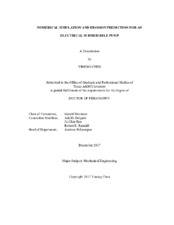| dc.description.abstract | Electrical Submersible Pumps (ESP) are widely used in the oil industry to lift oil and gas at the same time with high efficiency. Many ESPs operate with multiphase flow – liquid, gas and a low concentration of sand, thus having problems of pressure degradation and erosion. To investigate these problems, a numerical method can be used, which provides details of the inner flow field. Using the commercial software ANSYS Fluent, 3D transient multiphase simulations are conducted for a Baker Hughes made ESP MVP-G400. The simulations focus on three parts: secondary flow path in multiphase flow, pressure degradation due to gas volume fraction and erosion prediction.
Aside from the main flow path, the clearances and balancing holes inside the ESP create a secondary path which enables the flow to recirculate. Although the volume flow rate in this path is low compared with the main flow path, the erosion in the secondary path cannot be neglected and can result in pump failure. In this research, a water-air-sand three phase simulation is performed on dual stages of the ESP, with all secondary path included.
Second part of this research focuses on the pressure degradation due to the presence of a gas phase, especially at the first stage near the pump inlet. The compressibility of gas and the bubble break-up and coalescence effects are considered using the Population Balancing Module in ANSYS Fluent.
The last part is the erosion prediction. A low concentration of sand is often inevitable during the operation of an ESP, causing erosion and reducing the life span of the ESP. This erosion becomes more severe with the existence a of gas phase. The three-phase simulations with both Eulerian multiphase and particle tracking explain the erosion and the role of gas in this process, giving a reasonable qualitative prediction on the erosion of the ESP. | en |


